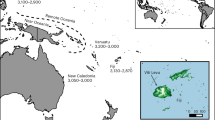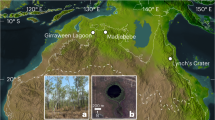Abstract
Biomass burning today constitutes approximately one-third of annual anthropogenic CO2 emissions, and there is a sound theoretical base for expecting fire-related changes in vegetation patterns to affect climate, at least on a regional scale1,2,3. But despite the central role that fire has played in moulding many modern ecosystems, there is little information on the incidence of fire before the earliest time at which anthropogenic burning may have significantly affected natural fire regimes. Here we present a million-year record of elemental carbon abundance from marine sediments on the Sierra Leone rise, ‘downwind’ of sub-Saharan Africa. Elemental carbon serves as a proxy for wind-blow debris derived from the combustion of sub-Sahara vegetation. The inferred fire incidence in the region was low until about 400,000 years ago, but since that time intense episodes of vegetation fires have occurred during periods when global climate was changing from interglacial to glacial mode. The occurrence of a peak in elemental carbon abundance within the present interglacial is unique in the past million years, suggesting that this peak is anthropogenic in origin, and that humans have exercised significant control over fire regimes in the region at least since Holocene times.
This is a preview of subscription content, access via your institution
Access options
Subscribe to this journal
Receive 51 print issues and online access
$199.00 per year
only $3.90 per issue
Buy this article
- Purchase on Springer Link
- Instant access to full article PDF
Prices may be subject to local taxes which are calculated during checkout


Similar content being viewed by others
References
Xue, Y. The influence and mechanisms of biosphere feedback on African climate. Int. Ass. Hydrol. Sci. Publ. 214, 119–125 (1993).
Hao, W. M., Liu, M.-H. & Crutzen, P. J. in Fire in the Tropical Biota(ed. Goldammer, J. G.) 452–465 (Ecological Studies Monogr. 184, Springer, Berlin,(1990)).
Andreae, M. O. in Global Biomass Burning: Atmospheric, Climatic and Biospheric Implications(ed. Levine, J. S.) 1–23 (MIT Press, Cambridge, MA, (1991)).
Bird, M. Fire, prehistoric humanity and the environment. Interdisc. Sci. Rev. 20, 131–154 (1995).
Kammen, D. M. & Marino, B. D. On the origin and magnitude of pre-industrial anthropogenic CO2and CH4emissions. Chemosphere 26, 69–77 (1993).
Schulz, E. Human impact and the anthropogenic nature of the west African Sahel. Progr. Abstr. Inter-INQUA (Canberra, Australia) 73 (Spec. Publ. Austral. Quat. Ass., Canberra, (1993)).
Hulme, M. & Kelly, M. Exploring the links between desertification and climate change. Environment 35, 5–45 (1993).
Petit-Maire, N. Lire l'avenir dans les archives Géologiques. Recherche 23, 556–564 (1992).
Rowell, D. P.et al. Modelling the influence of global sea surface temperatures on the variability and predictability of seasonal Sahel rainfall. Geophys. Res. Lett. 9, 905–908 (1992).
Smith, D. M., Griffin, J. J. & Goldberg, E. D. Spectrometric method for the quantitative determination of elemental carbon. Anal. Chem. 47, 233–238 (1975).
Herring, J. R. in The Carbon Cycle and Atmospheric CO2: Natural Variations from Archean to Present 419–442 (Geophys. Monogr. 32, Am. Geophys. Un., Washington DC, (1985)).
Wolbach, W. S. & Anders, E. Elemental carbon in sediments: Determination and isotopic analysis in the presence of kerogen. Geochim. Cosmochim. Acta 53, 1637–1647 (1989).
Emiliani, C., Price, D. A. & Seipp, J. in Stable-Isotope Geochemistry: A tribute to Samuel Epstein(eds Taylor, H. P., O'Neil, J. R. & Kaplan, I. R.) 229–231 (Spec. Publ. No. 3, Geochemical Soc., San Antonio, (1991)).
Verardo, D. J. Charcoal analysis in marine sediments. Limnol. Oceanogr. 42, 192–196 (1997).
Wolbach, W. S.et al. Global fire at the Cretaceous–Tertiary boundary. Nature 334, 665–669 (1988).
Smith, D. M., Griffin, J. J. & Goldberg, E. D. Elemental carbon in marine sediments: a baseline for burning. Nature 241, 268–270 (1973).
Verardo, D. J. & Ruddiman, W. F. Late Pleistocene charcoal in tropical Atlantic deep-sea sediments: climatic and geochemical significance. Geology 24, 855–857 (1996).
Cachier, H., Bremond, M. P. & Buat-Menard, P. Carbonaceous aerosols from different tropical biomass burning sources. Nature 340, 371–373 (1989).
Smith, B. N. & Epstein, S. Two categories of 13C/12C ratios for plants. Plant Physiol. 47, 380–384 (1971)
Ruddiman, W. F.et al. Site 668. Proc. Init. Rep. ODP Leg 108 (pt 2), 931–951 (1988).
Parkin, D. W., Phillips, D. R. & Sullivan, R. A. L. Airborne dust collection over the North Atlantic. J. Geophys. Res. 75, 1782–1793 (1970).
Pokras, E. M. & Mi, A. C. Eolian evidence for spatial variability of Late Quaternary climates in tropical Africa. Quat. Res. 24, 137–149 (1985).
deMenocal, P. B. Plio-Pleistocene African climate. Science 270, 53–59 (1995).
Dupont, L. Vegetation zones in NW Africa during the Bruhnes Chron reconstructed from marine palynological data. Quat. Sci. Rev. 12, 189–202 (1993).
Sarnthein, M.et al. Stable-isotope stratigraphy for the last 750,000 years: “Meteor” core 13519 from the eastern equatorial Atlantic. Meteor Forsch. C 38, 9–24 (1984).
Müller, P. J., Erlenkeuser, H. & von Grafenstein, R. in Coastal Upwelling: its Sedimentary Record(eds Theide, J. & Suess, E.) 365–398 (Plenum, New York, (1981)).
Verardo, D. J. & McIntyre, A. Production and destruction: control of biogenous sedimentation in the tropical Atlantic 0–300,000 years B.P. Paleoceanography 9, 63–86 (1994).
Bird, M. I. & Gröcke, D. Determination of the abundance and carbon-isotope composition of elemental carbon in sediments. Geochim. Cosmochim. Acta 61, 3413–3423 (1997).
Acknowledgements
We thank P. Weiss and C. Mato for assistance with the provision of samples from ODP-668B. This work was supported by a Queen Elizabeth II fellowship to M.I.B. from the Australian Research Council.
Author information
Authors and Affiliations
Corresponding author
Rights and permissions
About this article
Cite this article
Bird, M., Cali, J. A million-year record of fire in sub-Saharan Africa. Nature 394, 767–769 (1998). https://doi.org/10.1038/29507
Received:
Accepted:
Issue Date:
DOI: https://doi.org/10.1038/29507
This article is cited by
-
Changes in regional religious activities in the last millennium recorded by black carbon in Lake Dalzong, northeastern Tibetan Plateau
Science China Earth Sciences (2023)
-
Anthromes displaying evidence of weekly cycles in active fire data cover 70% of the global land surface
Scientific Reports (2019)
-
Climate and Fuel Controls on North American Paleofires: Smoldering to Flaming in the Late-glacial-Holocene Transition
Scientific Reports (2016)
-
Warming of an elevated layer over Africa
Climatic Change (2010)
Comments
By submitting a comment you agree to abide by our Terms and Community Guidelines. If you find something abusive or that does not comply with our terms or guidelines please flag it as inappropriate.



